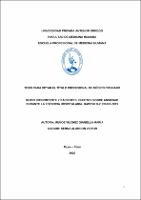Ruido intermitente y pacientes: efectos sobre ansiedad durante la estancia hospitalaria. HAPCSR II-2, Piura 2019

Ver/
Descargar
(application/pdf: 348.6Kb)
(application/pdf: 348.6Kb)
Fecha
2020Autor(es)
Muñoz Vílchez, Gianella María
Metadatos
Mostrar el registro completo del ítemResumen
Objetivo: Determinar la relación entre ruido intermitente y los efectos sobre
ansiedad en pacientes adultos durante su estancia hospitalaria, HAPCSR II-2, Piura
Metodología: Estudio transversal y correlacional. Población: 500 pacientes de las
áreas de Hospitalización y Emergencia del HAPCSR II-2, con una muestra
calculada de 218 participantes seleccionados por criterios de inclusión y exclusión
Resultados: Se identificaron los elementos físicos que generaban ruido, los cuales
fueron clasificados en ruido operacional y estructural. Los decibeles identificados
en Hospitalización y Emergencia se hallaron entre los 43.9 y 99.6 dB, señalándolos
como niveles no aceptables (97.2%). Durante la medición de la variable “ansiedad”,
se utilizó la escala de Hamilton para la ansiedad (HAM-A) que considera ansiedad
menor cuando la puntuación obtenida en la suma de los ítems se encuentra entre
6-14 puntos, y ansiedad mayor cuando el puntaje supera el valor de 15 y se asocia
a síntomas clínicos, obteniendo que el 35.8% de pacientes no tuvo ansiedad; el
37.2%, ansiedad menor y el 27.1%, ansiedad mayor. En el área de Emergencia, el
30.3% de pacientes no presentó ansiedad, 38.5% tuvo ansiedad menor y 31.2%,
ansiedad mayor. A comparación del área de Hospitalización, en donde se observó
que el 41.3% de pacientes no tuvo ansiedad, 35.8% presentaron ansiedad menor
y 22.9%, ansiedad mayor.
Conclusión: No existe relación entre el ruido intermitente y los efectos sobre
ansiedad en los pacientes adultos durante su estancia hospitalaria en el hospital
HAPCSR II-2, Piura. Objective: To determine the relationship between intermittent noise and the effects
on anxiety in adult patients during their hospital stay, HAPCSR II-2, Piura
Methodology: Cross-sectional and correlational study. Population: 500 patients from
the HAPCSR II-2 Hospitalization and Emergency areas, with a calculated sample of
218 participants selected by inclusion and exclusion criteria.
Results: The physical elements that generated noise were identified, which were
classified into operational and structural noise. The decibels identified in
Hospitalization and Emergency were between 43.9 and 99.6 dB, indicating them as
unacceptable levels (97.2%). During the measurement of the variable “anxiety“, the
Hamilton scale for anxiety (HAM-A) was used, which considers minor anxiety when
the score obtained in the sum of the items is between 6-14 points, and greater
anxiety when the score exceeds the value of 15 and is associated with clinical
symptoms, obtaining that 35.8% of patients did not have anxiety; 37.2%, minor
anxiety and 27.1%, major anxiety. In the Emergency area, 30.3% of patients did not
present anxiety, 38.5% had minor anxiety and 31.2%, major anxiety. Compared to
the Hospitalization area, where it was observed that 41.3% of patients had no
anxiety, 35.8% had minor anxiety and 22.9%, major anxiety.
Conclusion: There is no relationship between intermittent noise and the effects on
anxiety in adult patients during their hospital stay at HAPCSR II-2 hospital, Piura.
Palabras clave
Colecciones
- Medicina Humana [2969]

